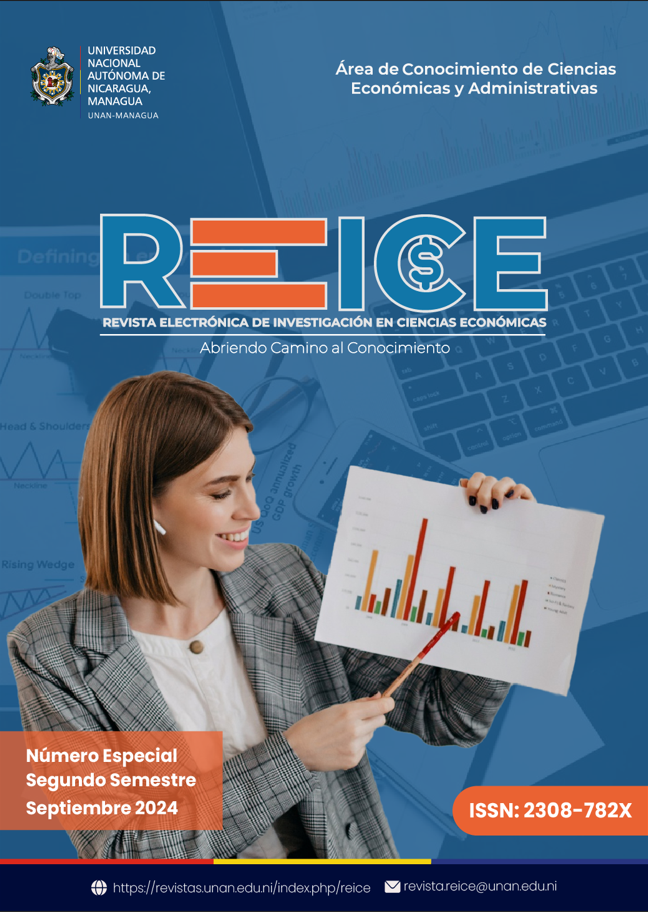Analyzing heterogeneous effects: How competition by informal firms affects firms’ productivity in Nicaragua
DOI:
https://doi.org/10.5377/reice.v1i2.18870Keywords:
Enterprise Survey, IRICI Index, Informal Competition, Productivity, Investment ClimateAbstract
Using data from the World Bank’s 2010 and 2016 Enterprise Surveys, this research analyzed how informality affects the performance of Nicaraguan formal firms. Utilizing indices (IRICI) of informal competition intensity, significant variations were found between economic activities. The results indicate that factors such as firm size, never having been informal, capacity utilization, and location outside of Managua decrease the perception of threat. The intensity of informal competition appears to increase productivity in large firms, neutralize it in medium-sized firms, and decrease it in micro and small firms. Interactive factors with the investment climate showed that the time spent handling regulations and informal payments negatively affect productivity under high informal competition. Other factors, such as the time needed to obtain an import license, can have positive effects, allowing firms to differentiate themselves. Access to credit reduces the perception of threat and has positive but not significant effects on productivity, highlighting ongoing historical limitations. To improve the study, it is necessary to incorporate more aspects associated with the theorized benefits of formality. Although preventive measures were applied, empirically, the results should be validated using instrumental variables to obtain an IRICI index at the level of economic activities corrected for potential endogeneity.
References
Ali, N., & Najman, B. (2016a). Informal Competition and Productivity in Sub-Saharan Africa.
Ali, N., & Najman, B. (2016b). Informal competition, firms’ productivity and policy reforms in Egypt. https://erf.org.eg/app/uploads/2016/07/1025.pdf
Amador, D. A. C., Hernández, E. J. S., & García, J. A. O. (2023). Economía Informal de Nicaragua: Una Estimación a Través del Método Monetario y de Consumo de Energía Eléctrica. Ciencia Latina Revista Científica Multidisciplinar, 7(6), 2991-3011. https://doi.org/10.37811/cl_rcm.v7i6.8898
Amin, M. (2021). Does Competition from Informal Firms Hurt Job Creation by Formal Firms? Evidence using Firm-Level Survey Data. The World Bank. https://doi.org/10.1596/1813-9450-9515
Aterido, R., Hallward-Driemeier, M., & Pages, C. (2009). Big Constraints to Small Firms’ Growth? Business Environment and Employment Growth across Firms. Economic Development and Cultural Change, 59, 609-609. https://doi.org/10.1086/658349
Bigsten, A., Kimuyu, P., & Lundvall, K. (2000). Informality, Ethnicity and Productivity: Evidence from Small Manufacturers in Kenya.
Castilleja-Vargas, L., & Enciso, S. (2019). Competencia informal y productividad en América Latina y el Caribe. IDB-TN-1699. https://publications.iadb.org/es/publications/spanish/viewer/Competencia_informal_y_productividad_en_Am%C3%A9rica_Latina_y_el_Caribe_es.pdf
Friesen, J., & Wacker, K. M. (2013). Do Financially Constrained Firms Suffer from More Intense Competition by the Informal Sector? Firm-Level Evidence from the World Bank Enterprise Surveys. SSRN Electronic Journal. https://doi.org/10.2139/ssrn.2267998
FUNIDES. (2016). Coyuntura Económica Nicaragua. Segundo informe 2016. (Coyuntura Económica). https://funides.com/wp-content/uploads/2019/09/Segundo_informe_de_Coyuntura_Econ%C3%B3mica_de_2016_para_imprenta.pdf
Gonzalez, A. S., & Lamanna, F. (2007). Who Fears Competition From Informal Firms ? Evidence From Latin America. The World Bank. https://doi.org/10.1596/1813-9450-4316
Hallward-Driemeier, M., Wallsten, S., & Xu, L. C. (2003). The Investment Climate and the Firm: Firm-Level Evidence from China (SSRN Scholarly Paper 373946). https://papers.ssrn.com/abstract=373946
Hosmer, D. W., Lemeshow, S., & Sturdivant, R. X. (2013). Applied logistic regression (Third edition). Wiley.
La Porta, R., & Shleifer, A. (2008). The Unofficial Economy and Economic Development.
La Porta, R., & Shleifer, A. (2014). Informality and Development. Journal of Economic Perspectives, 28(3), 109-126. https://doi.org/10.1257/jep.28.3.109
Loayza, N. (1997). The Economics of the Informal Sector. A Simple Model and Some Empirical Evidence from Latin America. https://documents1.worldbank.org/curated/en/685181468743710751/pdf/multi0page.pdf
Narvaez, A. B., & Rivera, F. C. (2016). Determinantes de la informalidad en Nicaragua. https://www.bcn.gob.ni/sites/default/files/revista/trabajos_volIII/Brenes_y_Cruz_2016.pdf
OIT. (2015). Encuesta de empresas sostenibles Nicaragua 2015. Identificación de obstáculos para el desarrollo empresarial. https://webapps.ilo.org/wcmsp5/groups/public/---ed_emp/---emp_ent/---ifp_seed/documents/publication/wcms_456501.pdf
Pessino, C. (1996). The Informal Sector in Nicaragua (Number 4; Economic Notes). The World Bank. https://documents1.worldbank.org/curated/en/192551491959180787/pdf/multi0page.pdf
Pisani, M. J. (2015). Does Informality Impact Formal Sector Firms?: A Case Study from Nicaragua. The Journal of Developing Areas, 49(2), 317-334. https://doi.org/10.1353/jda.2015.0033
Pisani, M. J. (2021). Challenges to formality from formal firms behaving informally: Evidence from Central America.
Pisani, M. J., & Yoskowitz, D. W. (2012a). A Study of Small Neighborhood Tienditas in Central America. Latin American Research Review, 47(S), 116-138. https://doi.org/10.1353/lar.2012.0055
Pisani, M. J., & Yoskowitz, D. W. (2012b). A Study of Small Neighborhood Tienditas in Central America. Latin American Research Review, 47(S), 116-138. https://doi.org/10.1353/lar.2012.0055
Soto, H. de. (1989). The Other Path: The Invisible Revolution in the Third World. Harper & Row.
Urcuyo, R. (2012). Microfinanzas y pequeñas y medianas empresas en Nicaragua.
World Bank. (2011). The Nicaragua 2010 Enterprise Surveys Data Set.
World Bank. (2014). Promoviendo la competitividad y el crecimiento inclusivo. Republica de Nicaragua, Memorando Económico de País.
World Bank. (2017). Description of Nicaragua ES 2016 Implementation.
Downloads
Published
How to Cite
Issue
Section
License

This work is licensed under a Creative Commons Attribution-NonCommercial-ShareAlike 4.0 International License.

